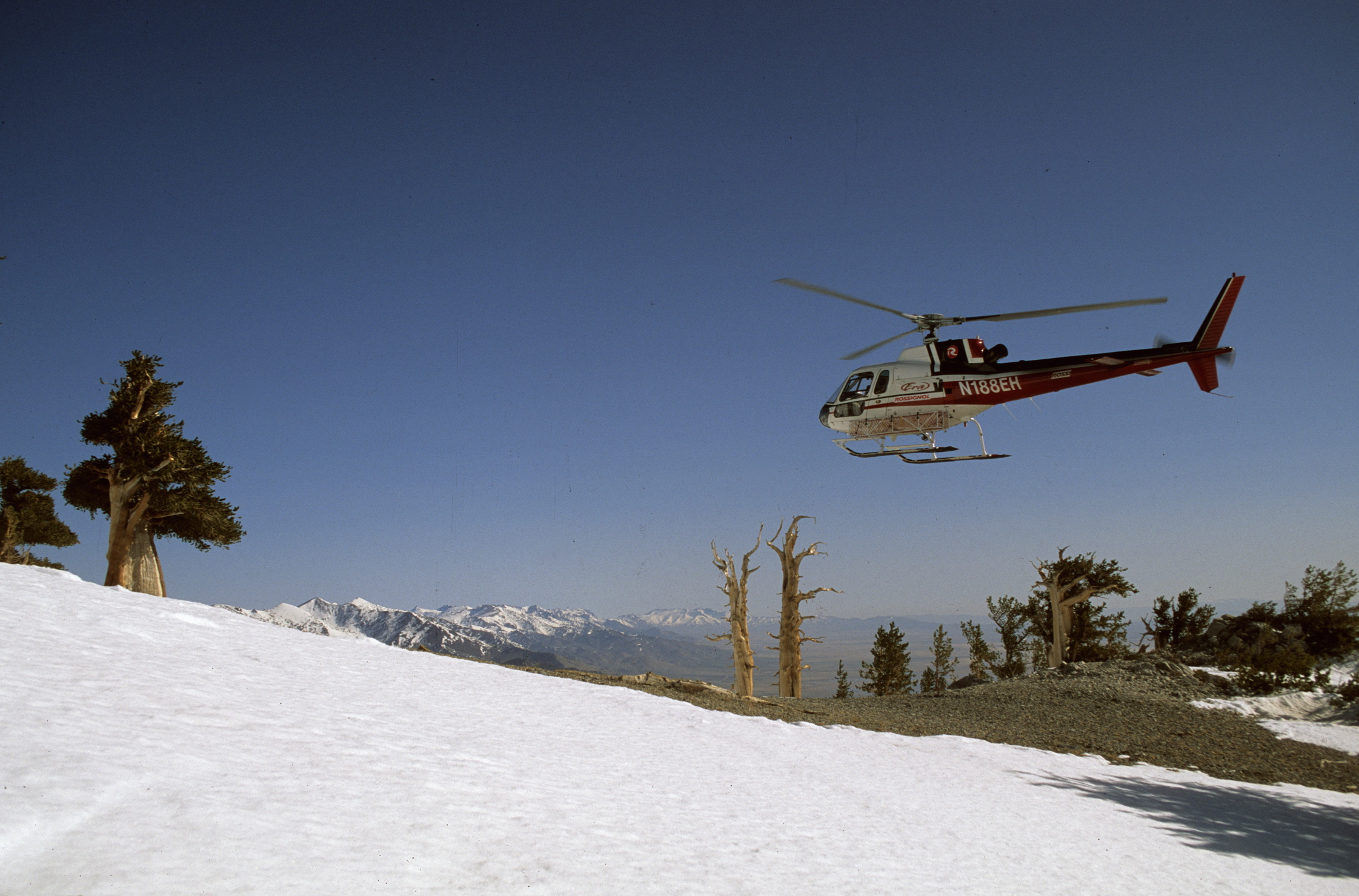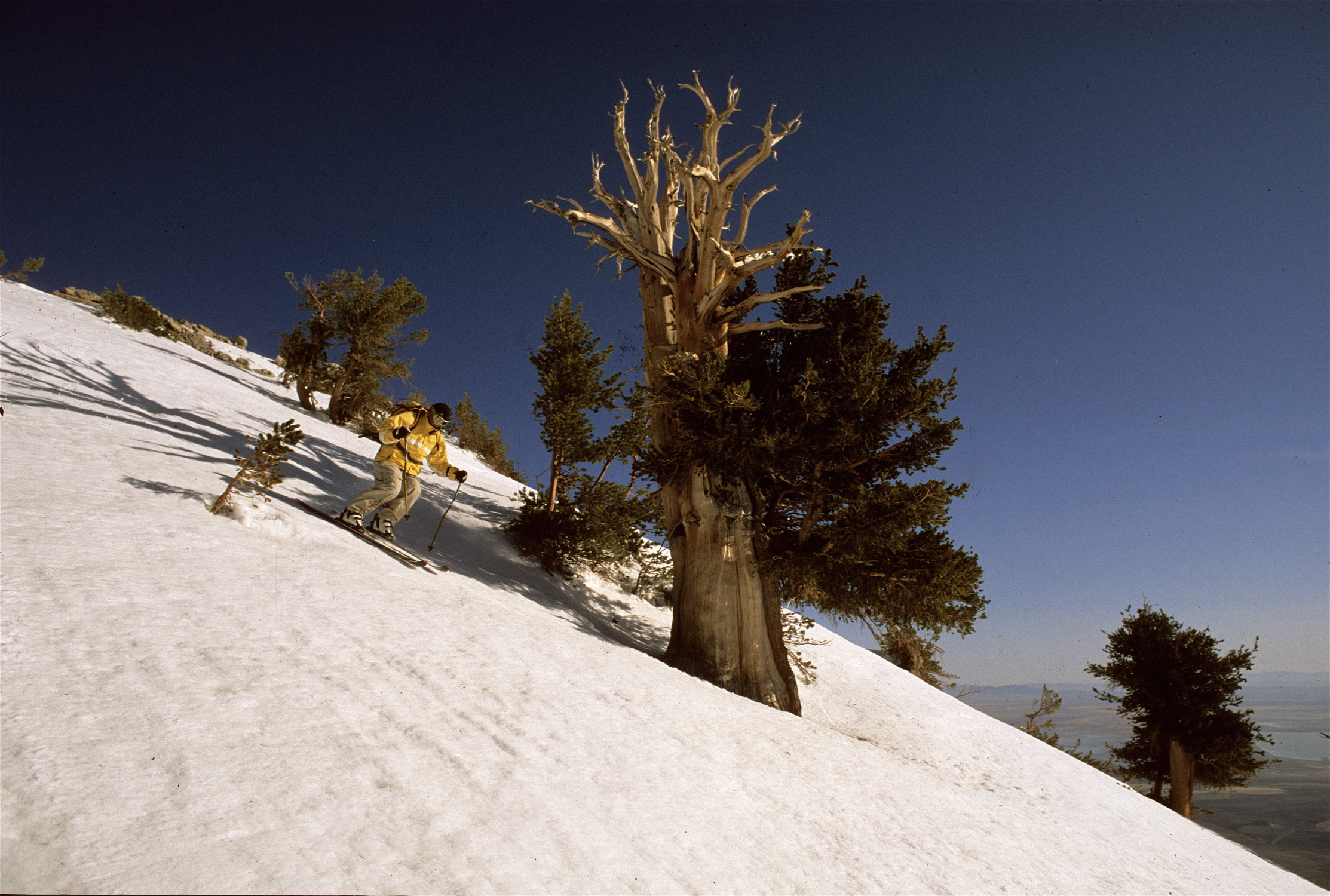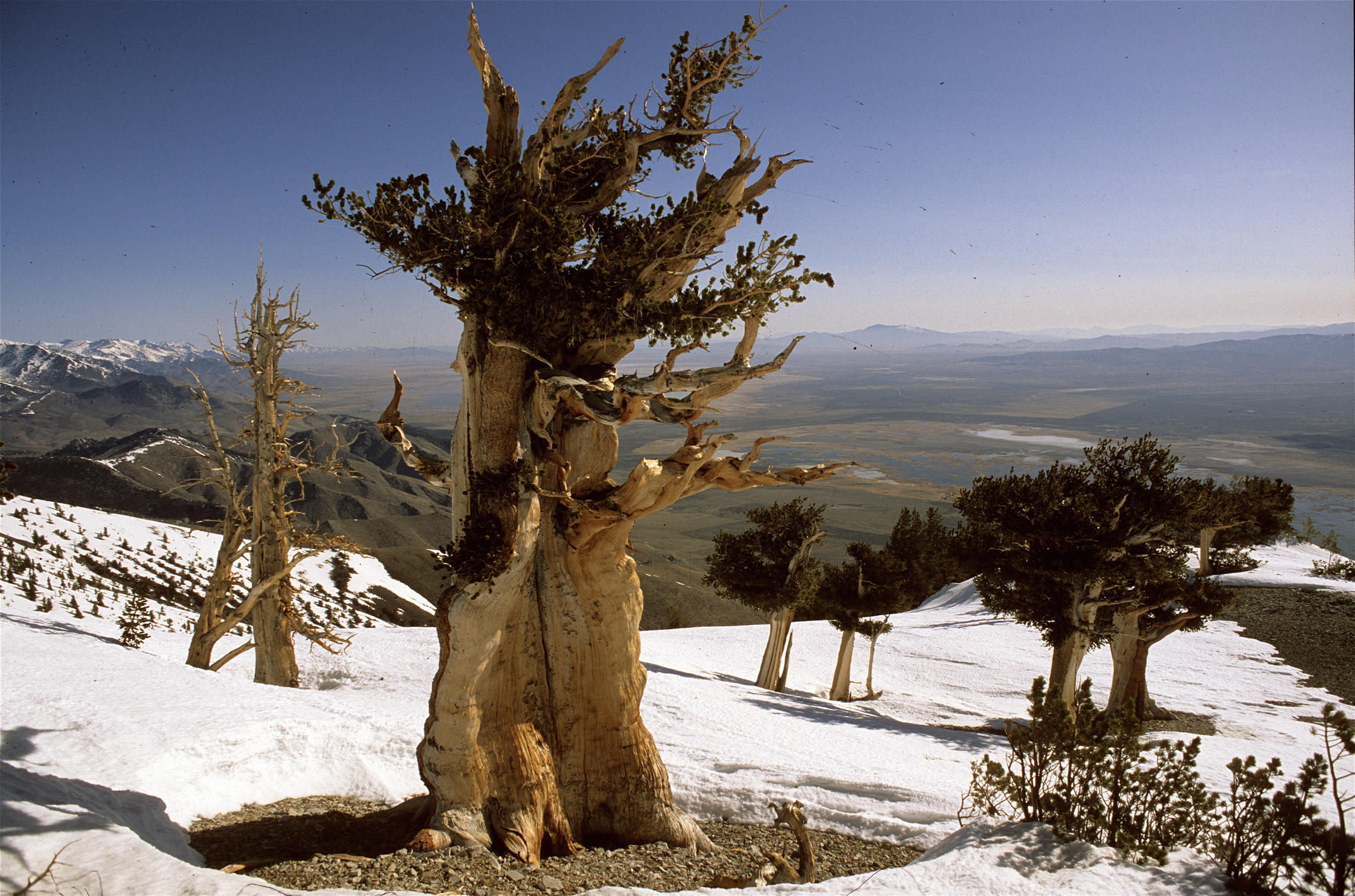Elko, Nevada: Bristle Cone Pines
“Belted into the back seat, I watch the ship’s shadow race across a grove of Bristlecone Pines toward the distant, windswept ridge.”
Bristlecone Pine,
Weathered For Eons, Still a Survivor
SKIING, BRISTLECONE PINEs
“The oldest known Bristlecone now lives far to the southwest in California’s White Mountains. Called the Methuselah Tree it is estimated to be 4,723-years old–two hundred years younger than Prometheus. For obvious reasons its location is kept secret.”
“And linking my own life to these weathered trunks, I wonder in the time it took to grow a single seven inch sprig, how many other men once stood in their shadows, died and turned to dust.”
It is early morning, 8:00 a.m. on March 20, the first day of Spring in Nevada’s Ruby Mountains. Alpin glow is lighting the Ruby’s east facing bowls as the A-Star hammers out of the valley shadows into the sunlight. Belted into the back seat, I watch the ship’s shadow race across a grove of Bristlecone Pines toward the distant, windswept ridge. I had planned to skin to the ridge, but the cost of Ruby Mountain Heliskiing’s single heli-lift was too good to resist. It spared me a three-mile hike through the creosote-covered desert to a four thousand vertical foot climb.
Helicopter Lift to Ruby Ridge Line
As the A-Star sets me on a windswept gravel ridge, a band of mountain goats race across the open bowl and onto a sheer rock out crop. The ship lifts, banks then falls toward Nevada’s Great Basin and I step into my skis and traverse across the frozen crust onto a tributary ridge. While I would welcome spring corn, or March powder I have no goal of ten, or twenty thousand vertical feet. Today skiing is a means to an end and half a dozen turns down the ridge, I stop beneath a forty-foot pine that eons of wind, heat and ice have forged into a living gargoyle.
ruby mountains. Elko, Nevada
Known as Pinus Longaeva the Bristlecone is, by far, the earth’s oldest known living organism. Some have survived in Nevada’s Snake and Ruby Mountains for five millennia and now exceed the age of the oldest Giant Sequoia and tallest Coastal Redwood by 1,500 years.
Bristlecones are solitary trees typically separated by a hundred or more feet. Here, at 11,000 feet the growing season lasts a scant forty-five days and, on the most ancient, much of the trunk and over story died a thousand years ago. Traversing from one tree to the next, I see what little growth does occur amounts to a thin ribbon of bark and islands of green on the twisted branches. Trapped between winter’s killing cold and summer’s brutal heat, the oldest add as little as an inch of girth every hundred years. Winds laced with ice and sand constantly prune the over story, thicken the trunk and force the roots deeper into the dry, nearly sterile alkaline soil. And yet these same hard winds discourage insects, fungus and rot adding to the tree’s longevity.
During my life the tree has grown less than half an inch. I cannot say whether a day and night, or a month or a year impacts these ancient pines–whether time is measured in centuries or a single heavy rainstorm, decade long droughts or the recurrent lightening strikes that have blasted black ribbons into the gray bark. Surrounded by the twisted trunks, I search for the monarch…. one tree taller, thicker or more deeply scarred that germinated during Egypt’s Fourth Dynasty when masons set the massive corner stone for Cheop’s Pyramid.
BRISTLECONE PINES
High in the Rubys, tallest, strongest, most massive are relative terms. All depend on luck. The tallest may have grown from a seed that was blown into an eddy where February snows harden into deep drifts and wind blown minerals bury twisted roots. Without counting rings, it is impossible to pick the oldest. It may very well be the tallest or, just as likely, a horizontal trunk that four thousand years of hard winds sculpted into a natural bonsai.
For tens of thousands of years, altitude and isolation helped protect the Snake Range’s Bristlecones. Then, in 1964, while studying the last ice age on 13,000 foot Wheeler Peak, a University of North Carolina doctorial candidate broke his boring tool in what back packers called the Prometheus Tree. Named after the Greek god Titan who Zeus shackled to the Caucuses for giving fire to man, Prometheus was ancient. How old, no one could say. Short on time and out of boring tools, the aspiring professor sought permission from the Forest Service to drop the tree and count its rings. There is no record of how many hours it took to saw through the massive trunk. Or, if he experienced any guilt when it crashed to the ground. What is known, is the young researcher killed the world’s oldest known living organism. The single act of cutting the bristlecone would bring him far more notoriety than anything he would accomplish in his long, unremarkable academic career. Prometheus’ 4950 rings chronicled a history of infrequent rains and past droughts, one of which from 1215 to 1299 A.D. forced the starving Pueblo Indians out of their cliff face homes.
The oldest known Bristlecone now lives far to the southwest in California’s White Mountains. Called the Methuselah Tree it is estimated to be 4,723-years old–two hundred years younger than Prometheus. For obvious reasons its location is kept secret.
In my years I have stared up California Coast Redwood’s towering trunks and marveled at Yosemite’s Sequoias. Now, carving turns through the Ruby’s glades, I am moved by the Bristlecone’s tortured beauty. No two trees are alike and the twisted trunks and islands of green define a personality as surely as my great grandfathers weathered face spoke of time, experience and undeniable strength of character.
Bristlecone Sentinels
I traverse into the bowl and finish a hundred turns toward the waiting A-Star. The air warms, the snow softens and the Ruby Marshes glisten beneath my ski tips. The Bristlecones thin then fall behind me. Turning uphill, I study the scattered trees and realize that virtually all of recorded human history has passed in the time since they took root. And linking my own life to these weathered trunks, I wonder in the time it took to grow a single seven inch sprig, how many other men once stood in their shadows, died and turned to dust.



